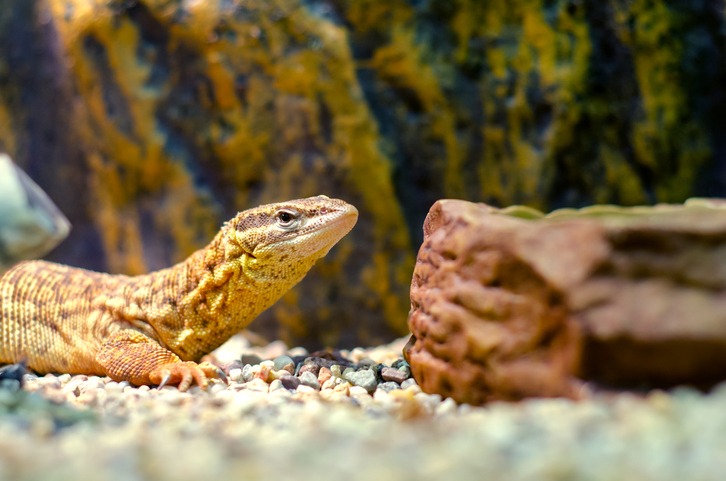The Ackies Monitor, also known as Spiny-tailed Monitor, Ridge-tailed Monitor, Ackie’s Dwarf Monitor, and Varanus acanthurus, is a monitor species usually found in Australia. They inhabit the dry regions and scrubland areas of Western Australia, and parts of Northern Territory and Queensland. This species is one of the most famous lizard pets because of its striking characteristics and mellow temperament. If you are interested to learn more about the Ackies Monitor, make sure to read further!
History
Ackies Monitors are part of the similar genus as the Komodo Dragon. These lizards live in rocky outcroppings, retreating in crevices and puffing up their bodies to squeeze themselves between rocks when frightened. They seek refuge in humid burrows they dug deep themselves to take shade and regulate their hydration and temperature levels during the hottest hours of the day.
This species was first described in 1885 by Belgian-British zoologist George Albert Boulenger. Three subspecies of Ackies Monitor were recognized:
- a. acanthurus – Found in northwestern and northern Australia
- a. brachyurus – Located in western and central Australia, Queensland
- a. insulanicus – Found in Groote Eylandt and Wessel group islands
Characteristics of an Ackies Monitor
Average length: 24-28 inches
Average life span: 15 to 20 years
The Ackies Monitor possesses a prehistoric look that makes them a favorite among reptile hobbyists. Ackies Monitors come in varying colors, but the most common color you will see is brown. Its back is dark brown, while its back is dark brown. Its rich color comes with varying spots and stripes colored yellow or cream.
Its tail has some amazing features as well. Its tail, which measures about 1.2 and 2.3 times as long as its head and body combined, makes up the most of its total length. It has spinose scales, which gives off a lizard’s signature spiky look. The difference between male and female Ackies Monitors are very subtle. Males tend to come in longer lengths and buffier physique than females.
In the wild, they are diurnal, ground-dwelling lizards mainly found under rock slabs, crevices, and boulders. They have a lower activity level than other lizards, making it easier for them to adapt appropriately to life in captivity.
Caring for an Ackies Monitor
Taking good care of an Ackies Monitor is not as difficult as it may seem, but it doesn’t mean it will not come with stringent care requirements.
Unlike other lizards, the Ackies Monitor is not an agile climber. In fact, it’s quite the opposite. They need an adequate amount of room to hunt, bask, explore, and burrow, so you will need a thick substrate layer (at least 6 inches), a durable enclosure to accommodate its hobbies. A glass terrarium that’s at least twice the length of your pet is the standard, although you can still provide more room for it. For substrates, choose the best materials that help hold onto moisture. A bit of moisture helps the Ackies Monitor cool down and hydrated. On top of a thick substrate, you will need to decorate the enclosure with pieces of cork bark stacks, wood, faux caves, artificial plants, and the like to mimic the lizard’s natural habitat. Not only will it make your pet more comfortable, but it will also make it less stressed, which is good to increase its life span.
Since the Ackies Monitor lives in scorching areas, it will need a temperature gradient. Provide a basking spot that reaches 120 degrees Fahrenheit. On the other side, the cool side should be around 80 degrees Fahrenheit. Remember that Ackies Monitors cannot tolerate temperatures that are below 65 degrees. Your pet will also need a UVB lamp that will produce ultraviolet rays that it needs to stay healthy. UVB rays provide vitamin D, an essential vitamin to maintain bone structure.
Your pet would also require a good amount of humidity, preferably between 65 and 85 percent. You may use a hygrometer to measure the levels regularly.
In the wild, Ackies Monitors eat a variety of food sources. In captivity, they can also take various aliments, such as cockroaches, crickets, mice, mealworms, snails, eggs, shrimp, and canned food diets. While an Ackies Monitor can eat dog and cat food, it is not recommended as a part of its diet. All food items, except rodents, should be dusted with calcium or vitamin powder.

